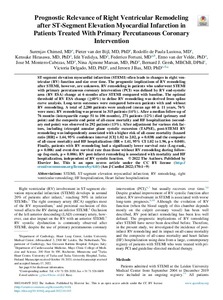Prognostic Relevance of Right Ventricular Remodeling after ST-Segment Elevation Myocardial Infarction in Patients Treated With Primary Percutaneous Coronary Intervention
Chimed Sunjarev; van der Bijl Pieter; Lustosa Rodolfo de Paula; Hirasawa Kensuke.; Yedidya Idit; Fortuni Federico; van der Velde Enno; Montero-Cabezas Jose M; Marsan Nina Ajmone; Gersh Bernard J; Delgado Victoria; Bax Jeroen J.
https://urn.fi/URN:NBN:fi-fe2022081154513
Tiivistelmä
ST-segment elevation myocardial infarction (STEMI) often leads to changes in right ventricular (RV) function and size over time. The prognostic implications of RV remodeling after STEMI, however, are unknown. RV remodeling in patients who underwent STEMI with primary percutaneous coronary intervention (PCI) was defined by RV end-systolic area (RV ESA) change at 6 months after STEMI compared with baseline. The optimal threshold of RV ESA change (≥40%) to define RV remodeling was derived from spline curve analysis. Long-term outcomes were compared between patients with and without RV remodeling. A total of 2,280 patients were analyzed (mean age 60 ± 11 years, 76% were men). RV remodeling was present in 315 patients (14%). After a median follow-up of 76 months (interquartile range 51 to 106 months), 271 patients (12%) died (primary end point) and the composite end point of all-cause mortality and HF hospitalization (secondary end point) was observed in 292 patients (13%). After adjustment for various risk factors, including tricuspid annular plane systolic excursion (TAPSE), post-STEMI RV remodeling was independently associated with a higher risk of all-cause mortality (hazard ratio [HR] = 1.44, 95% confidence interval [CI] 1.02 to 2.02, p = 0.038) and the composite of all-cause mortality and HF hospitalization (HR = 1.41, 95% CI 1.02 to 1.96, p = 0.040). Finally, patients with RV remodeling had a significantly lower survival rate (Log-rank, p = 0.006) and event-free survival rate than those without RV remodeling during follow-up (log-rank, p = 0.006). RV post-infarct remodeling is associated with mortality and HF hospitalization, independent of RV systolic function.
Kokoelmat
- Rinnakkaistallenteet [27094]
